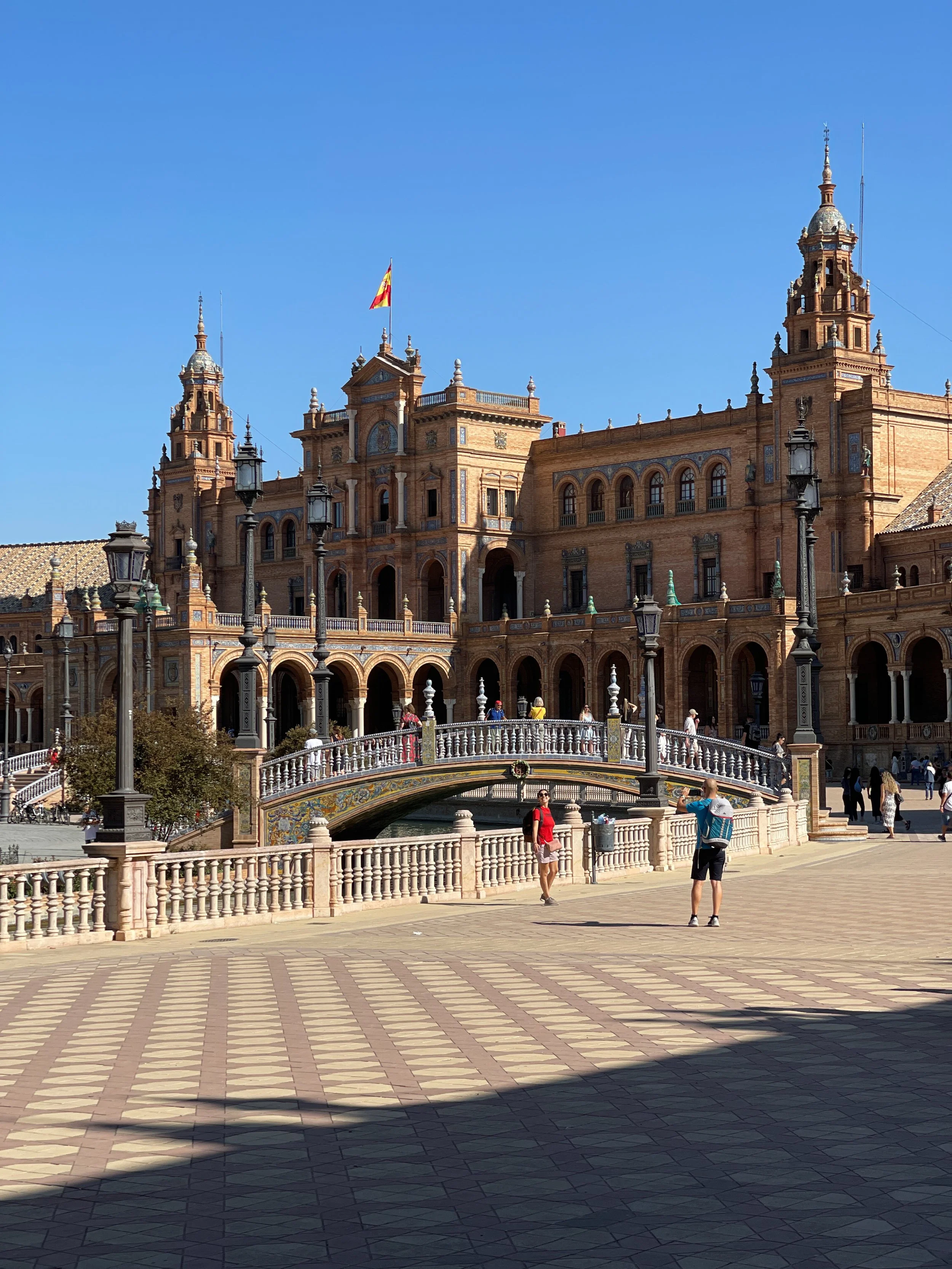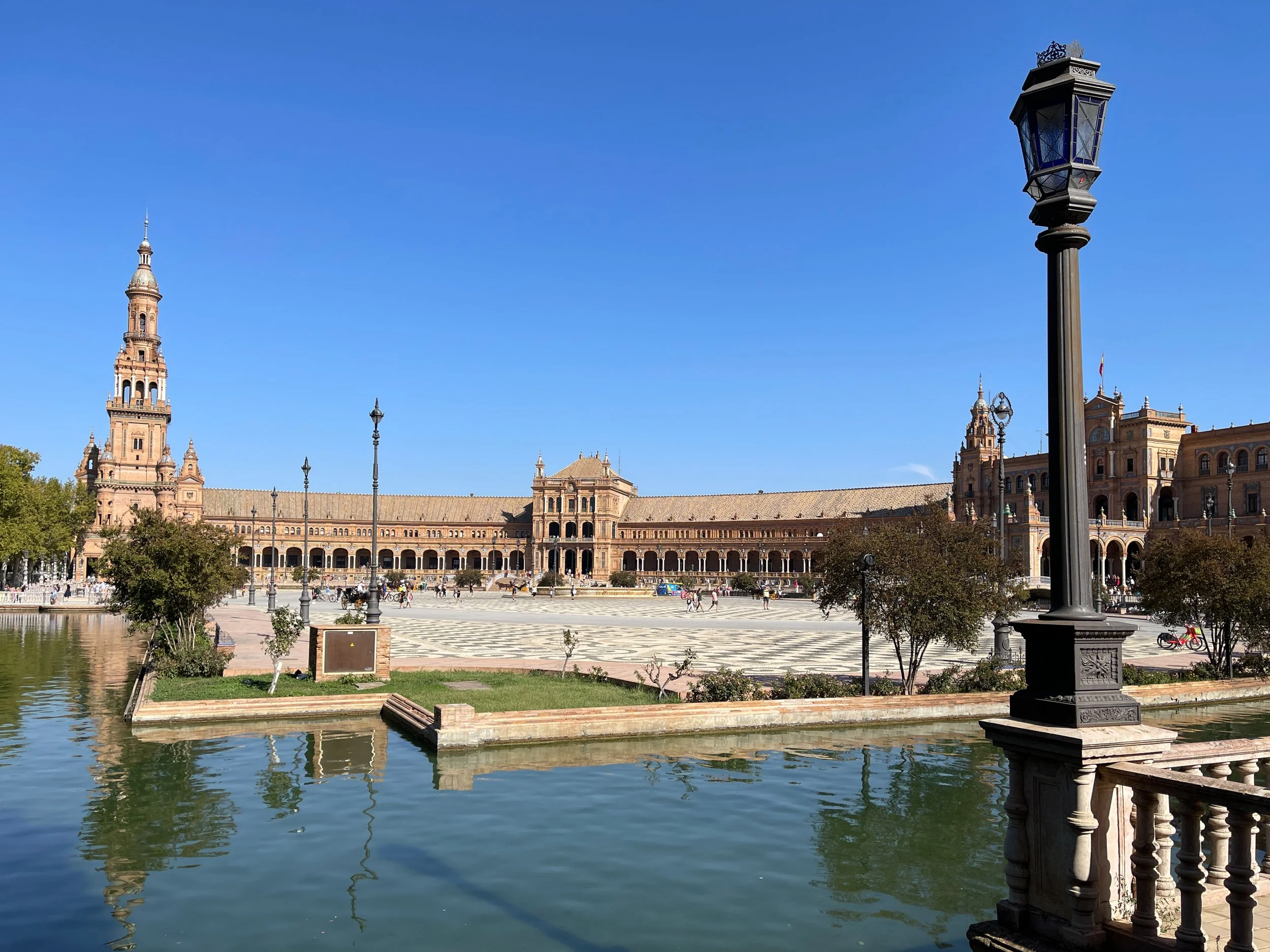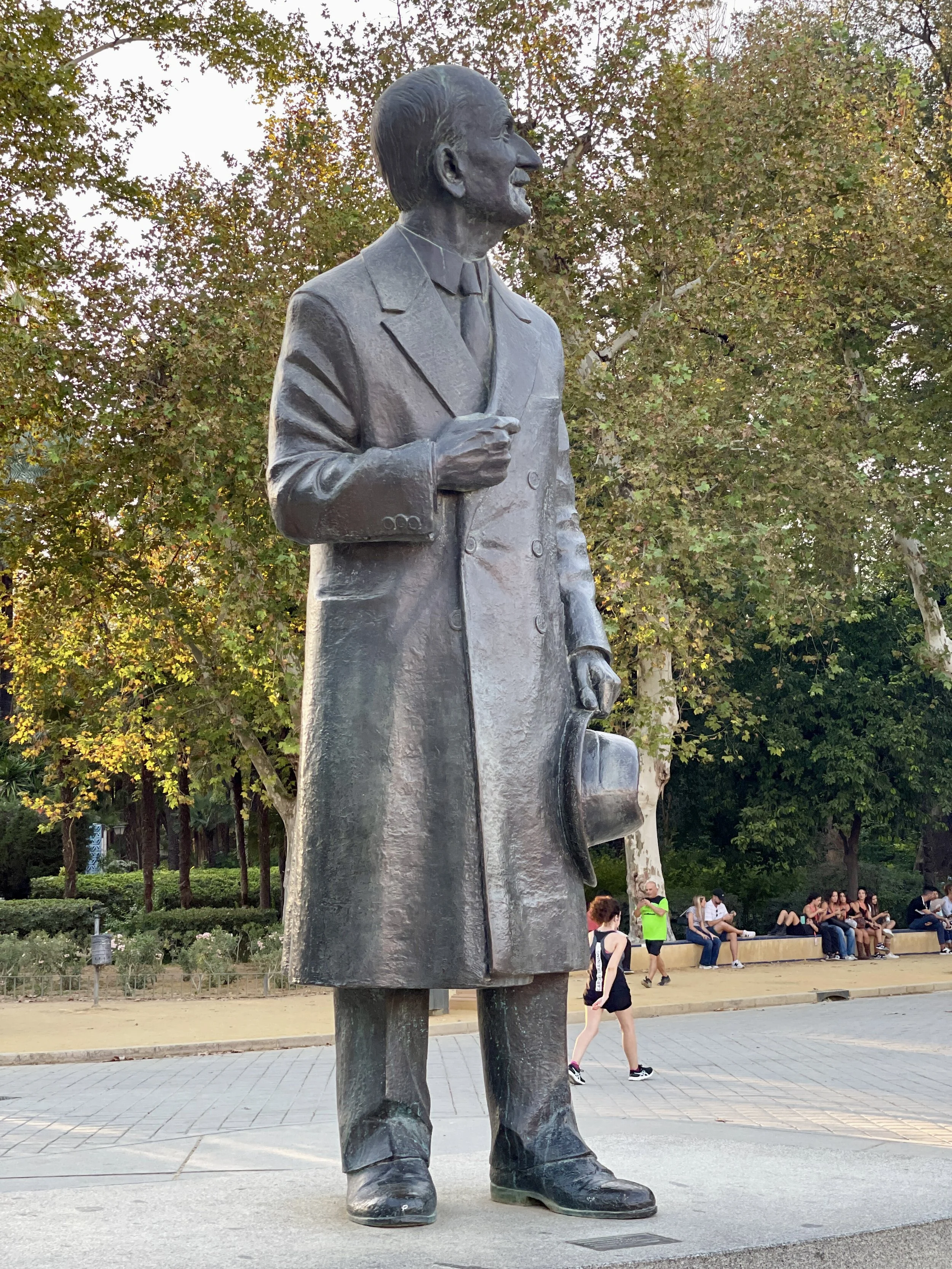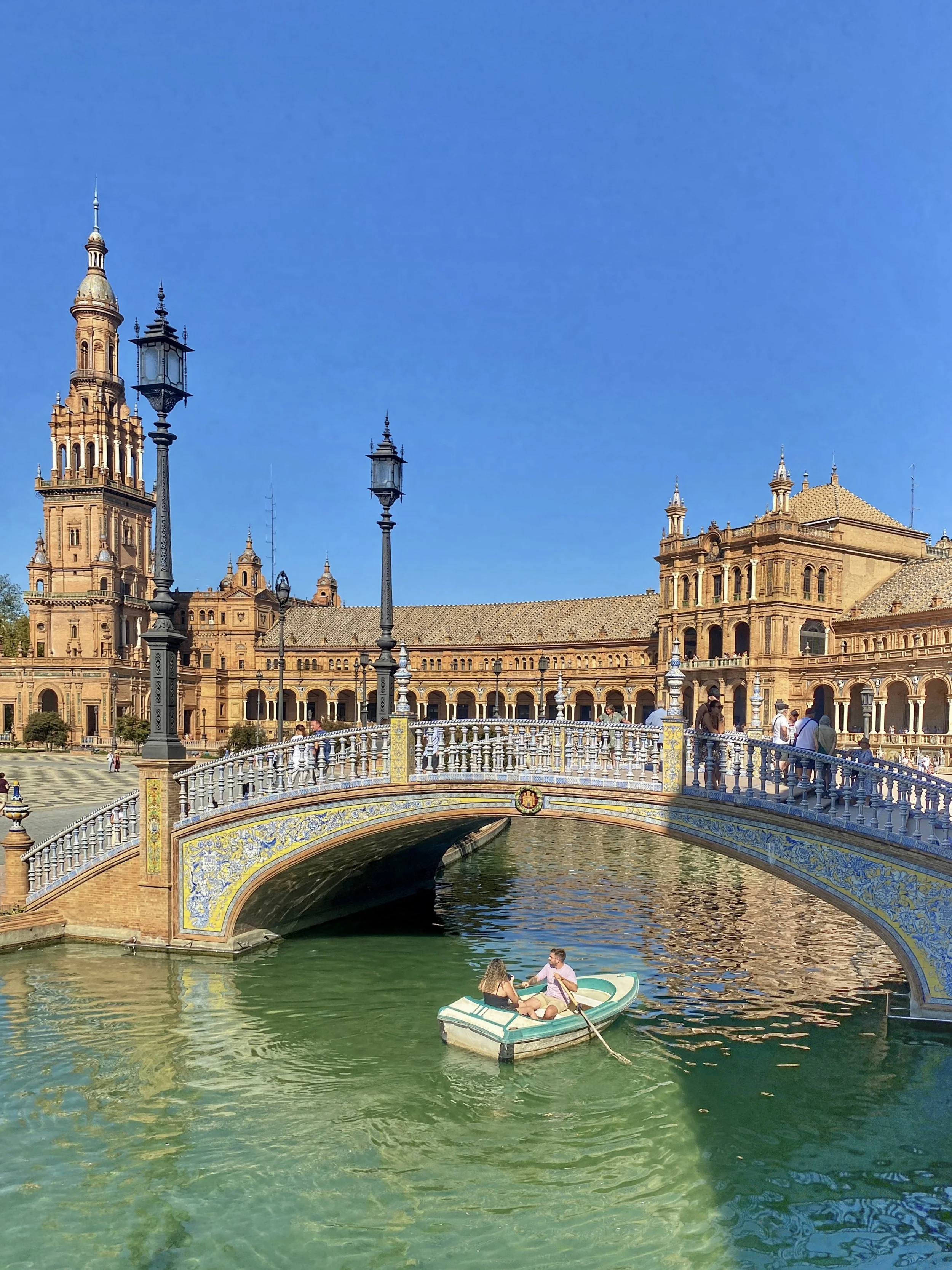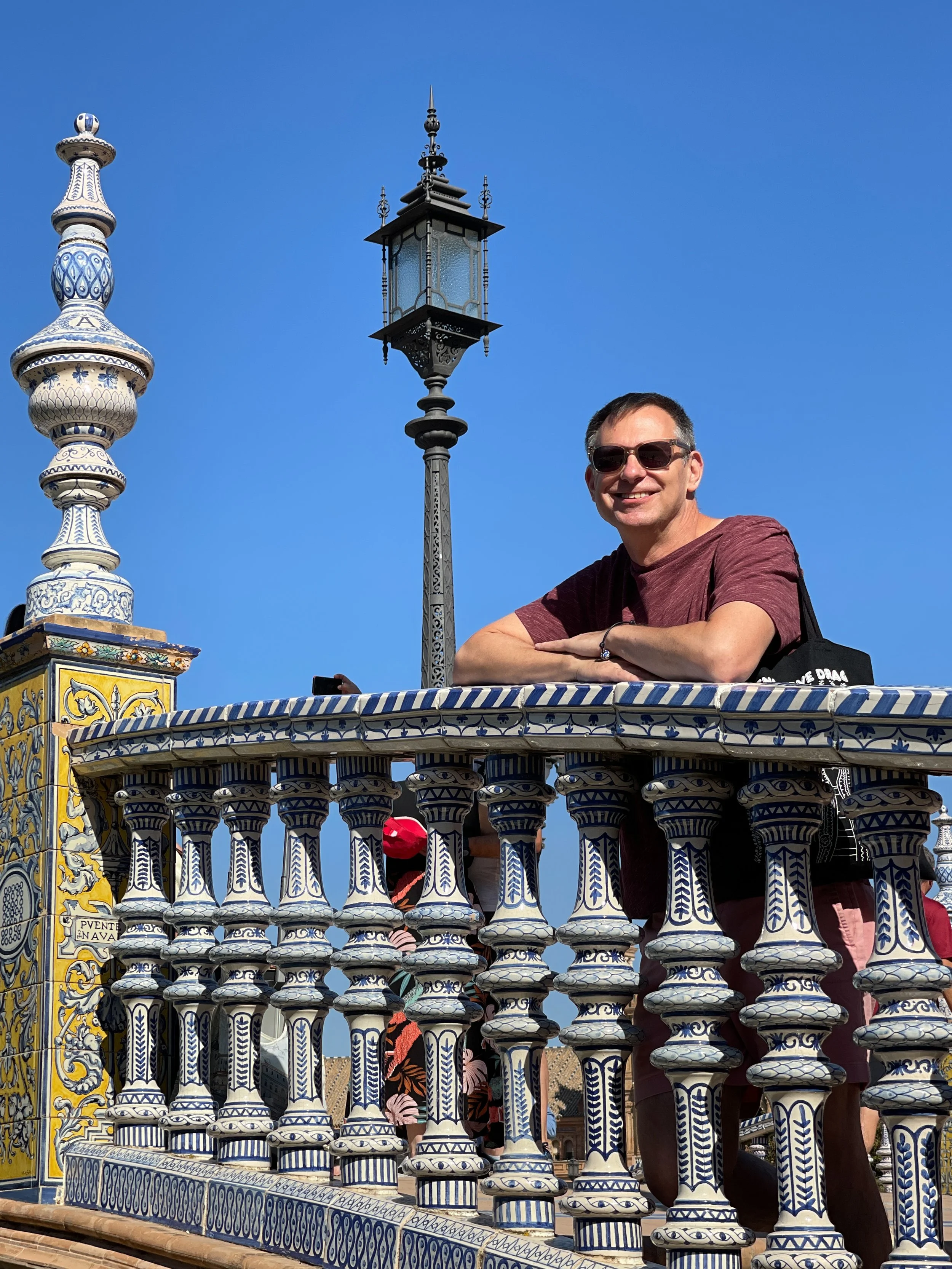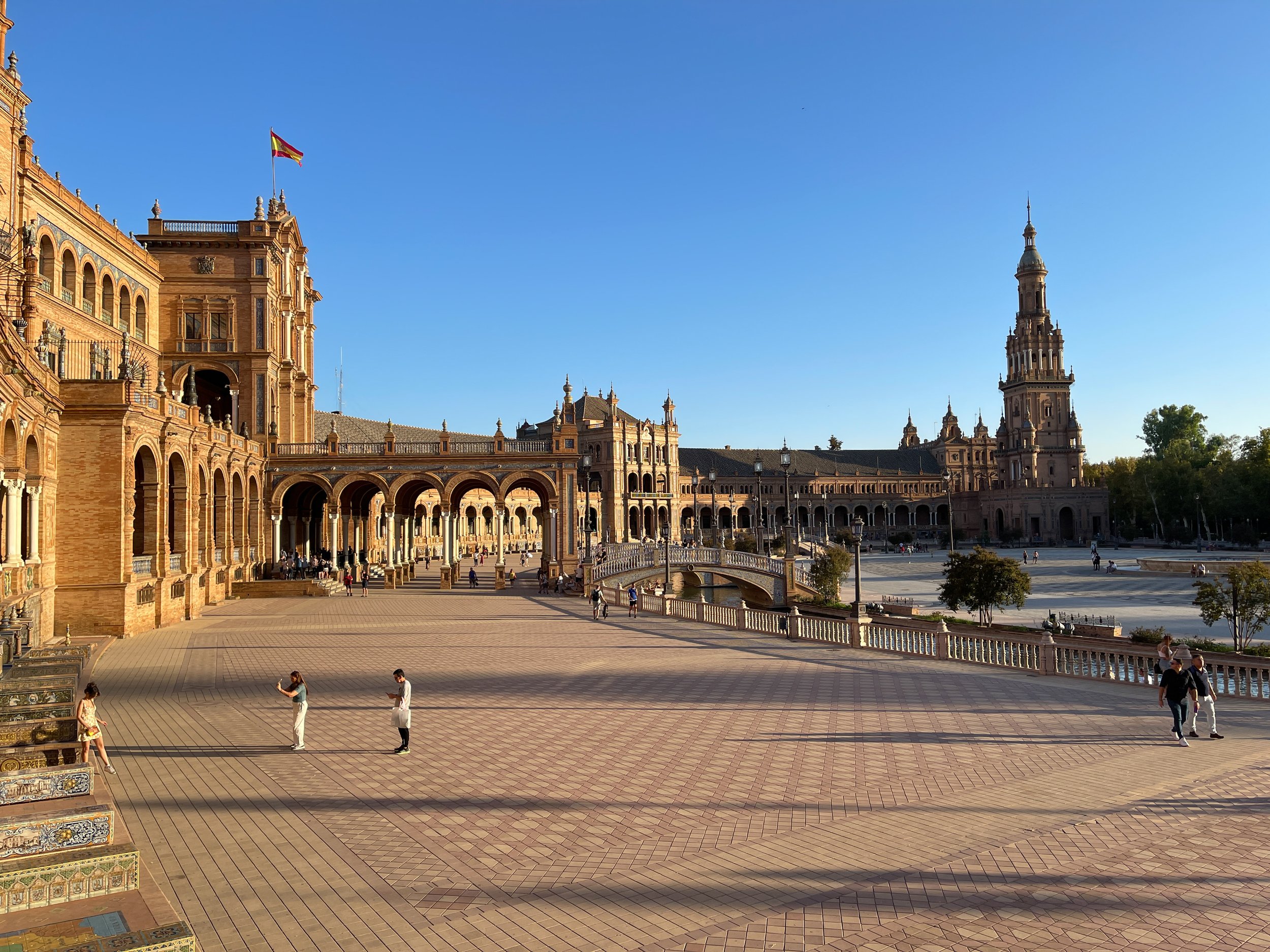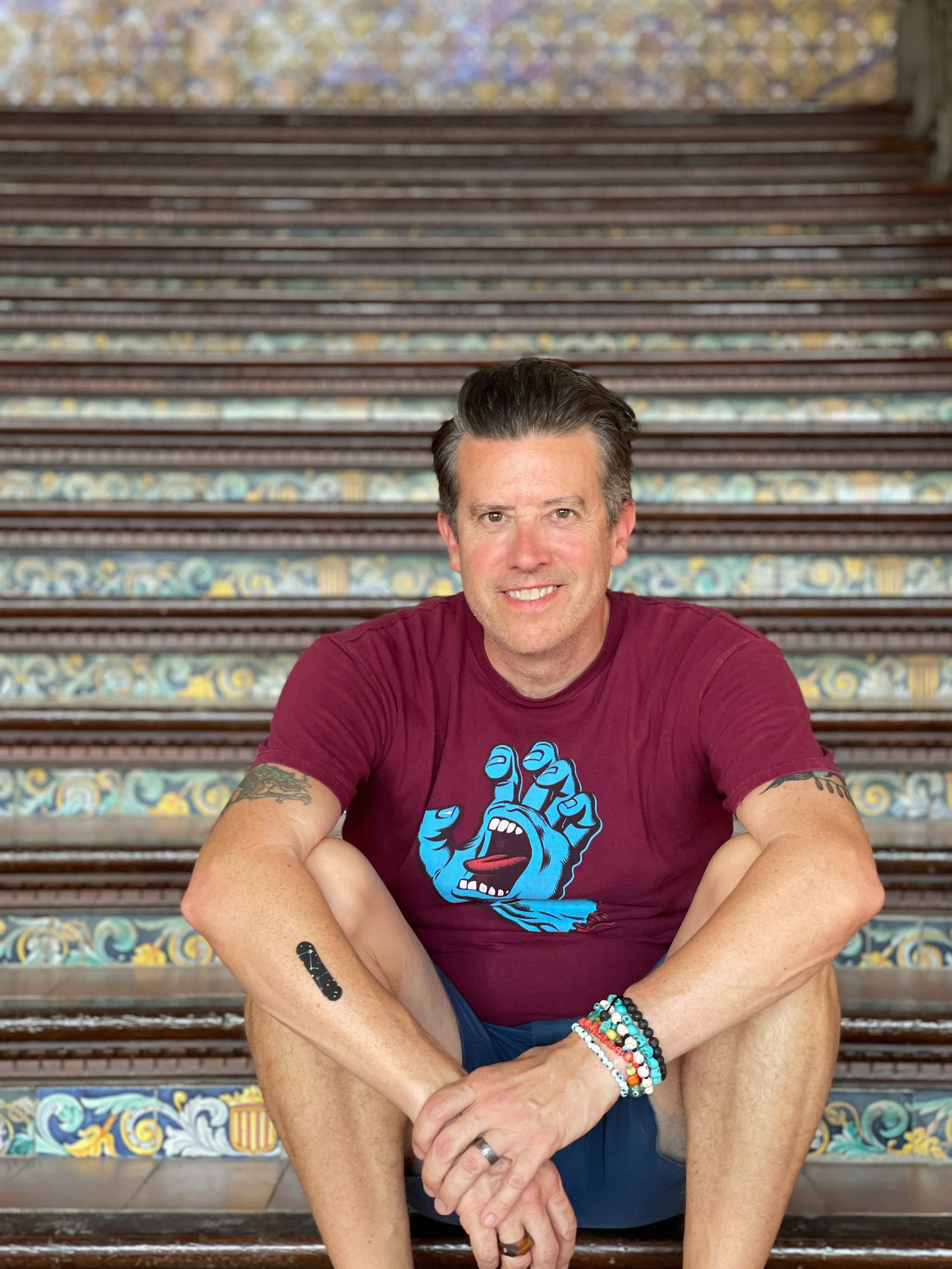Discover the stunning tile alcoves in this iconic landmark from the 1929 Ibero-American Exposition (and a Star Wars movie).
There’s talk that city officials might actually start charging admission because of overtourism in the Plaza de España.
It was love at first sight. Wally and I were instantly captivated by the cuisine, history and diverse architecture of Andalucía, the southernmost region of Spain. On our first trip there, we spent a couple of idyllic days with our friend Dan in Sevilla. We both agreed that when we returned, we’d plan to spend more time in the capital city of Andalusia.
Even the railings of the bridges are gorgeous in the Plaza de España.
Earlier this year, we got our chance and stayed at an incredible Airbnb in Seville close to the Casco Viejo, or Old Quarter, with a rooftop view of the Catedral de Sevilla. One of the places we wanted to revisit was the Plaza de España, which was within walking distance from our accommodation. The city is quite walkable, flat and easy to navigate. Of course, this will depend on your level of mobility and whether you’re willing to walk (we always are).
Unlike other expositions, where most structures were temporary and torn down after the event, the elaborate Andalusia Pavilion was built to be permanent and was constructed using traditional materials such as brick, ceramic, iron and wood.
A Brief History of the Plaza de España
The Plaza de España includes the Pabellón de Andalucía (Pavilion of Andalusia), which was built to showcase Spain’s industrial and technological achievements at the 1929 Exposición Ibero-Americana (Ibero-American Exposition).
This popular destination is nestled among the trees and flowers of Parque María de Luisa, which was formerly the private gardens of the Palacio de San Telmo. The land, donated to the city in 1893 by Infanta María Luisa Fernanda de Bourbon, Duchess of Montpensier, now serves as the city’s primary green space.
One of 48 portrait medallions from ceramicist Pedro Navía’s Triana studio depicting illustrious figures from Spain’s history, including this one of King Alfonso X “el Sabio” aka the Wise, who ruled from 1252-1284.
The idea of hosting a fair in Sevilla was first proposed by civil engineer Luis Rodríguez Caso in 1908 as part of an extensive urban development project designed to boost economic growth and improve trade relations with Spain’s former Latin American colonies.
Construction began in 1914 under the supervision of prominent architect Aníbal González. Unfortunately, World War I interrupted these plans, and delays were further exacerbated in 1918 by a particularly virulent strain of the H1N1 virus, estimated to have claimed 260,000 lives in Spain before waning a year later.
The plaza currently houses numerous administrative offices. Our friend Jo, an expat from the U.K. living in Spain, admitted to us that while the space is gorgeous, it also reminds her of the hours she spent in a bureaucratic nightmare of immigration red tape.
Stunning architecture and rich history come together at the iconic Plaza de España in Sevilla.
Visiting the Plaza de España
The Plaza and Fountain
The monumental structure, covering 538,196 square feet (50,000 square meters), was designed by González in the Regionalist style, which combines elements of Baroque, Mudéjar and Renaissance Revival. The grand fountain, added by architect Vicente Traver y Tomás, rises from the center of the plaza courtyard and was inspired by the Montjuïc fountain in Barcelona. (It was off during our visit due to a severe drought that had lasted for most of the year.)
The porte-cochère acts as the grand entrance of the Plaza de España, now home to administrative offices.
Flamenco dancers often perform beneath the columned central portico of the Pabellón de Andalucía at the Plaza de España.
Head to the upper gallery for a shaded walk and a great way to see the beauty of the plaza unfold below.
The original plans for the plaza didn’t include a fountain, but town officials insisted on adding one, much to González’s dismay. And according to local lore, that’s why the statue of González, standing at the axis of the pavilion’s crescent, faces away from the fountain.
Local lore has it that the likeness of architect Aníbal González is turned away from the fountain —added by Vicente Traver y Tomás — because he wasn’t a fan of the feature.
The main structure is capped by a pair of domed towers that were originally planned to be much taller. However, concerns arose that they would end up dwarfing La Giralda, the iconic bell tower of the Seville Cathedral. To ensure this wouldn’t happen, they were shortened to 243 feet (74 meters) high — 77 feet less than La Giralda.
The South Tower of the Plaza de España stands about 243 feet (74 meters) tall.
Between 2007 and 2010, the plaza underwent a meticulous 14 million euro renovation, which included the installation of ceramic lamp posts and railings around the canal, restoring the landmark to its former glory. About €5 million was used to replace the pipes and update the canal’s water supply system. While the building’s various government offices aren’t open for tours, you can still admire the interior colonnade and access the upper floor balconies to take in a view of the plaza from above.
In the Córdoba alcove, the hand-painted azulejo mural portrays the moment the city surrendered to King Ferdinand III of Castile. The Torre Campanario of the Mezquita-Catedral de Córdoba is visible on the left, while the Torre de la Malmuerta stands on the right.
The Tiled Alcoves
As you walk around the central plaza, vibrant color is everywhere — every possible variation and combination of greens and blues, ranging from the aquamarine of the shallow shore to the cerulean blue of the deep ocean, with a visual jolt of cadmium yellow.
The outer rim of the plaza’s pavilion has 48 alcoves with plinth-style benches, clad in azulejos, glazed ceramic tiles produced in Triana, a neighborhood renowned for its ceramic artists, across the river from Sevilla’s historic center.
Among the four dozen tile and ceramic murals representing the provinces of Spain in Seville’s Plaza de España, the painted tiles from Ciudad Real show Don Quixote in armor, as the noble knight he imagined himself to be, preparing to battle windmills alongside his squire, Sancho Panza.
Each shrine-like space is dedicated to a different Spanish province, and includes a tile map of its territory, its coat of arms and a tableau depicting a historical event or cultural scene from the region.
Pillared shelves topped with pináculos, ceramic finials, flank the alcoves. Initially, I assumed these shelves might have been for holding votive candles, but I learned that they once held pamphlets with information about each province during the exposition.
This vibrant alcove at the Plaza de España features a colorful tableau for Badajoz, depicting King Alfonso IX of León’s recapture of the city from the Muslims in 1230 CE.
Beautiful details cover almost every inch of the plaza, many of which are the work of ceramicist and sculptor Pedro Navía y Campos. His craftsmanship can be seen in the 40 portrait medallions honoring prominent figures from Spain’s history that adorn the spandrels of the porticoed gallery.
Charming rowboats glide across the canal, offering a unique and serene way to experience the beauty of Plaza de España.
The Bridges
The Venetian-style footbridges that gracefully arch over the canal add a picturesque charm to the plaza and beautifully complement the symmetry of the pavilion.
Elegant bridges span the canal, blending Moorish, Renaissance and Spanish architectural styles.
They’re named after the four historical kingdoms of Spain: Castile, León, Navarre and Aragón. These bridges connect the open courtyard to the main building and galleries. Their blue and white balustrades were crafted by ceramist Manuel García Montalván. The administrative building is surrounded by a 1,690-foot-wide (515-meter) moat, where visitors can rent rowboats and leisurely paddle around. Wally and I haven’t done so yet — but we plan to in the future.
Star Wars fans will particularly love visiting the Plaza de España, as it was a filming location for Theed Palace in Naboo where Anakin and Padmé fall in love during Star Wars II: Attack of the Clones.
Movies Filmed at Plaza de España
The Plaza de España has been used as a filming location for a few well-known movies, including Lawrence of Arabia (1962), where it served as a backdrop for Cairo, Egypt, and Star Wars Episode II: Attack of the Clones (2002), when Anakin and Padme, followed by R2D2, arrive on Naboo and walk through the colonnade of the Palace of Theed. Most recently, it appeared as the palatial complex of an eccentric autocrat in The Dictator (2012) by Sacha Baron Cohen.
Plaza de España, a stunning architectural marvel in Sevilla, boasts a grand semicircular building, vibrant ceramic tile decorations and a serene canal, making it a captivating symbol of Spain’s artistic and cultural heritage.
The Lowdown
While we were exploring, we witnessed a wannabe influencer who clearly expected everyone to move aside as she directed her husband to take a photo of her standing on the stairs as if she were the only one there. When the crowds didn’t clear for her to get “the perfect shot,” she had a meltdown and stormed off, leaving her husband with their baby and stroller to chase after her.
Don’t be this woman. She threw a tantrum when other tourists refused to step aside so she could get her perfect shot.
The Plaza de España is located near the entrance of Maria Luisa Park across from the Universidad de Sevilla (University of Seville) and is about a five-minute walk following Avenida de Isabel la Católica.
Even the staircases of Plaza de España are adorned with exquisite tilework.
If you’re planning on visiting during the daytime be sure to wear sunscreen to prevent sunburn and bring bottled water to stay hydrated, as the majority of the plaza is open and exposed.
There aren’t any public bathrooms within the main pavilion, but there are pay toilets in a compact building at the front of the plaza, which cost 60 céntimos to use.
Paseo de Isabel la Católica offers a peaceful stroll amid lush greenery, with Plaza de España on one side and Parque de María Luisa on the other.
The Plaza de España is currently free to enter, but concerns about managing overtourism and the costs of preserving the historic site have prompted city officials to consider imposing an entry fee for non-citizens.
Whatever the outcome may be, we suggest spending a lazy afternoon admiring this special place. –Duke



